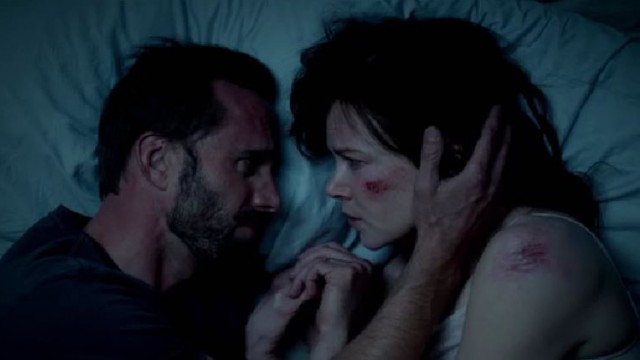The initial setup for Strangerland couldn’t possibly get any more familiar: a small-town teenage girl with a troubled family life disappears into the night. After she never returns, the family begins looking for her. Both director Kim Farrant and writers Fiona Seres and Michael Kinirons realize that this plot is just a hook on which to hang their message, but what starts out as a clear message becomes muddled and confused as Strangerland competes with Oliver Stone’s U-Turn with crazy backwater desert town antics.
Lily Parker’s (Maddison Brown) voice opens the film with the first of many repetitions of this same bit of terrible teenage poetry:
Touch in the dark
No one can see
Touch in the dark
You Touch Me.
I hope you thought that was deep because it pops up again and again throughout the film as if this poem is a skeleton key to unlock all of the secrets within Strangerland.
The Parkers have recently moved to a small backwater desert town deep in Australia’s outback, a town reeking of failure and desperation, because of something that Lily did. When we first meet Lily, she’s still rebelling against society. While babysitting her younger brother, Tommy, she takes him to the punk skate park/homeless refuge came where she bums a cigarette before having sex with an older kid in a shipping container. Later that night, she runs away from home, with her sleepwalking little brother in tow, and never returns. The next day, a sand storm hits the city.
Their parents, Catherine (Nicole Kidman) and Matthew (Joseph Fiennes), also are having problems of their own. They don’t sleep in the same bed, they don’t have sex, and Matthew seems intent on punishing Catherine for Lily’s rebellion. When Lily disappears, Matthew practically puts the responsibility on Catherine. The whole town becomes tenuously involved in finding Lily and Tommy, but the bizarre personalities make this a very fraught venture. Eventually, skeletons fall out of closets everywhere.
With a grueling 115 minute run time, Farrant keeps turning the knife over and over again, in turn opening up a Pandora’s Box of questions and issues. Who was Lily sleeping with? Was it the mentally challenged black kid who helps with odd jobs around the town? Was it the kids in the skate park? Was it the cop? Did they have anything to do with it? What about the past? What about Catherine’s past?
The main theme she keeps coming back to is the complicated issue of female sexuality, and how men perceive women in modern society. Catherine is a woman who has sexual urges constantly denied by Matthew. Lily has sexual urges that have been demonized by her father and the whole town. In one of the most pointed observations, the topic of Lily’s promiscuity is always up for judgement and assessment, but nobody is looking at the sexuality of any of the men or boys she was sleeping with.
Farrant’s cinematography constantly isolates the women and highlights their desperation. This is the tale of Catherine and Lily’s oppression writ large for the whole town to see. Early in the film, Joseph declares that he doesn’t want another scandal like they had in their old city, foretelling that their lives will be laid out for everybody’s judgement once again. The women have nowhere to go, so then what?
Though I mention U-Turn as a familiar movie, Strangerland most resembles another movie about a desperate woman trapped by her circumstances: Dogville. In both, women are reduced to objects of gratification while at the hands of an bizarre and selfish town. Their characters are made out of reductionist tropes in order to dissect and/or subvert a larger thematic identity. To top it off, both fims are pessimistic as hell and pissed off about it. Even if Strangerland can’t quite get past some of its own idiotic idiosyncrasies, the effort is more than unsettling and different enough to be fascinating.

